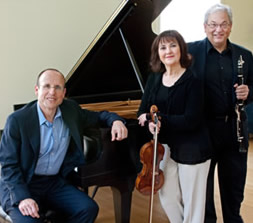The cold, wet, gloomy weather continued well into Sunday, November 17, on one of the busiest and eclectic musical weekends in recent memory. Despite the weather outside being frightful, this did little to deter music lovers from attending one or more of the many offerings.
The Chamber Orchestra of the Triangle (COT) presented their second concert of the 2002-3 season at their usual time and place: Sunday at 3:00 p.m. in the Carolina Theatre in downtown Durham.
One of the perks in this newly found endeavor (i.e. reviewing) is the opportunity finally to hear many local ensembles, some of which, despite being in existence for many years, I have somehow missed. Formerly named the “St. Stephen’s Chamber Orchestra,” this organization is a model of what a community-based non-profit arts organization can and should be. Well-funded with a healthy list of mostly individual donors, the COT also extends its energies to mentoring young musicians. Lorenzo Muti, Conductor and Artistic Director, has been at the helm of this group, which labels itself as “an authentic classical orchestra,” since 1988.
The afternoon began with brief remarks by a board member of the COT, accompanied by a very loud and annoying electrical buzz coming from the sound system. Knowing the large technical fees that are paid to the Carolina Theatre for any performance, this was inexcusable. It also detracted somewhat from the excellent commentaries that Maestro Muti gave before each piece. Fortunately, someone remembered to turn the sound system off after each use of the microphone.
I took my place in my favorite seat in that theater – first row balcony. What I thought may have been an omission of several cellists in the program was obviously wrong. Indeed, the COT uses only three cellos in its lineup. I felt that this contributed to a significant overall balance problem since the other strings were more in line with the usual numbers – six first violins, five seconds, and four violas. Despite the outstanding technical and ensemble work of this small section, throughout the concert I felt a lack of depth and “bottom” that should contribute so much to the total effect of even an “authentic classical orchestra.”
The afternoon began with an early, rarely-played score by the Bohemian/Czech composer Leos Janacek.. The Suite for String Orchestra is a work in search of an individual style. Muti was right on the money when, in his remarks, he described this as an amalgam of the compositional techniques of the day with little evidence of the nationalistic Czech style that was to become a hallmark of Janacek’s operas and more mature orchestral works. The work is in six relatively short movements and is a charming if not particularly distinctive creation. Muti, conducting choral-style, sans baton, led the group in an effective and incisive reading.
The next piece featured the afternoon’s featured soloist, clarinetist Alexander Fiterstein. Mozart’s Concerto for Clarinet and Orchestra, in A Major, is one of the most-loved and popular works. Written late in his short life around the time of The Magic Flute , this concerto exhibits all the traits of what makes Mozart so great. Sandwiched between two lively and virtuosic outer movements is a central Adagio that is somber, grieving and achingly beautiful. The strings were joined onstage by the wind players – two each of flutes, bassoons, and horns. This work, probably the most famous wind concerto, and an essential part of any clarinetist’s repertoire, is one that when played well you never grow tired of hearing. Fitesrtein gave a masterful performance. Technically impeccable, he displayed the wide range of emotion that makes the concerto so great. Elegant and graceful in the Allegro he proceeded to the wistful melancholy of the Adagio emerging into the exuberant and playful Rondo. His tone was equally full and sure throughout all the registers of the instrument. Muti was exceptional in maintaining the balance in a concerto accompaniment – a skill often overlooked. The winds blended beautifully in an ideal vehicle for an orchestra of this size.
Tchaikovsky’s Serenade for Strings, Op. 48, despite being described as an ” hommage à Mozart ” and classical in structure, is far from the delicate and graceful concerto just heard. This is an immensely popular work, from its premiere to the present day, and it has become a staple of many smaller orchestras. It ranges from a typical Sonata-Allegro first movement to themes based on Russian folk songs to a waltz that could be straight out of one of his great ballets. Muti is a wonderfully expressive and physical conductor, almost moving into the orchestra at times to elicit his ideas. The orchestra played this audience favorite with a convincing and expressive touch. I did feel again that the three cellos were outmatched sorely in volume, observing instead of actually hearing what they were playing in several sections. This is a minor critique in an otherwise joyful and sunny end to a rainy afternoon. An added bonus was a very nice reception afterwards in the downstairs lobby of the theatre.












